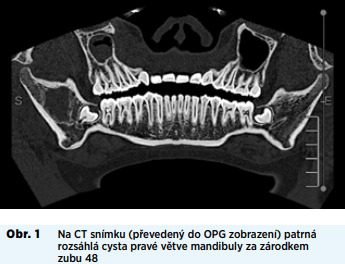Possibilities of using an expert system in the diagnosis of jaw cysts
Expert system are among the most successful applications of artificial intelligence. Since their commercial introduction in the early 1980s, they have undergone rapid development and are now ušed in many areas of human activity, such as science, technology, manufacturing, business, etc. Recently, they have also started to appear more and more in the field of medicine.
INTRODUCTION
In 1988, Feigenbaum defined expert systems as computer programs that simulate the decision-making activities of an expert in solving complex problems, using appropriately encoded, explicitly expressed special knoledge taken from the expert in order to achieve specialist level decision quality in a chosen problem domain
However, this definition cannot be taken as binding and the only valid one, because different expert system. There are also often differences in the architectures of the different tyres and also in the specific application tasks, which can be very diverse, especially in medicine. Moreover, these ideas are changing with the development of artifical intelligence, and it is possible that the above afinistion will no longer be useful in the future.
The term expert system first appeared in the early 1970s. Among other fields, medicine is one of the main fields where expert systems are used. Proof of this is, among other things, that one of the first expert systems to be developed was designed to rapidly verify bacterial infections from readily available information. It was mainly used for initial diagnosis, which was quicker that laboratory tests, and was also helpful in the selectionof antibiotics. It was a ground-breaking system and the methods used in it are still valid today. For example, the Oncocin system, which helped trat cancer patients, and the Clot system, which fokusem on blood coagulation disorders, were based on the same platform as Mycin.
One of the most important is the Internist system, which aims to cover the entire field of interval medicine. It is one of the most comprehensive expert systems ever and, together with its modification, the Caduceus system, is still in use today.
As mentioned, an expert system is usually a computer program. It may not always be a stand-alone user application. Different systems may be nested within other larger application to from part of a complex software product.
Expert systems are therefore in no way intended to replace the experience and intuitivní of an expert in decision making. They are intended to achived the best possible solution by comfronting the input data entered into the system's user interface with the built-in knowledge base, decision tree and interface for differential diagnostic judgment and treatment design. The more knowledge a real expert transmits to the system, the more faithful its response will be.
The goal of the study was to develop and clinically evaluate an expert system to facilititate the diagnosis of jaw cysts.
CASE REPORT
A 17 year old girl was referred to our department for an incidental finding on an OPG scan. It was a cystic lucency in the branch of the mandible on the right. Subjectively, the patient was without difficulty. Objectively, the face was symmetrical, mouth opening was unrestricted, dentition was sanitized, and the bite was in anatomical position. Anamnestically, she reported an accident suffered two years previously, during which she had been struck on the right side of her face. A CT scan was therefore taken, which clearly showed a circumscribed mass behind the retinated tooth 48, but not in contact with it (Figs. 1, 2). The data obtained was also entered into an expert system, which suggested a diagnosis of post-traumatic hemorrhagic pseudocyst with a treatment proposal with possible postoperative complications. The finding was also consistent with the clinical differential diagnosis of the expert system.

